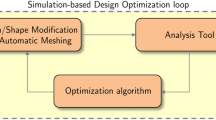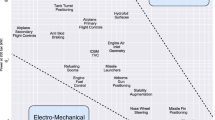Abstract
The main objective of this article is to describe the development of two advanced multiobjective optimization methods based on derivative-free techniques and complex computational fluid dynamics (CFD) analysis. Alternatives for the geometry and mesh manipulation techniques are also described. Emphasis is on advanced strategies for the use of computer resource-intensive CFD solvers in the optimization process: indeed, two up-to-date free surface-fitting Reynolds-averaged Navier-Stokes equation solvers are used as analysis tools for the evaluation of the objective function and functional constraints. The two optimization methods are realized and demonstrated on a real design problem: the optimization of the entire hull form of a surface combatant, the David Taylor Model Basin—Model 5415. Realistic functional and geometrical constraints for preventing unfeasible results and to get a final meaningful design are enforced and discussed. Finally, a recently proposed verification and validation methodology is applied to assess uncertainties and errors in simulation-based optimization, based on the differences between the numerically predicted improvement of the objective function and the actual improvement measured in a dedicated experimental campaign. The optimized model demonstrates improved characteristics beyond the numerical and experimental uncertainty, confirming the validity of the simulation-based design frameworks.
Similar content being viewed by others
Abbreviations
- B n (t):
-
Bezier curve of degree n
- D P, D O :
-
Experimental value of the parent and the optimized designs
- E Δ :
-
Difference between the measured and the expected improvements
- f, f 0, etc.:
-
Fitness function
- \( \vec F \) = (F 1, F 2, ..., F N )T :
-
Multiobjective functions
- F n = \( {U \mathord{\left/ {\vphantom {U {\sqrt {gL_{PP} } }}} \right. \kern-\nulldelimiterspace} {\sqrt {gL_{PP} } }} \) :
-
Froude number
- \( \bar f(t) \) :
-
Average fitness of a population
- g :
-
Gravitational acceleration
- h, g :
-
Equality and inequality constraint functions
- L PP :
-
Ship length
- M :
-
Number of design variables
- m :
-
Number of processors
- n :
-
Population size
- N :
-
Number of multiobjective functions
- N i,p , N i,q :
-
Normalized B-spline basis functions of degree p and q
- p, q :
-
Number of equality and inequality constraint functions
- P, Q, R :
-
Grid clustering and stretching functions
- P i,j :
-
Location vectors of nonuniform rational B-spline (NURBS) control points
- P o, δP :
-
Original and displacement location vectors
- r :
-
Penalty parameter
- R n = UL PP /v :
-
Reynolds number
- R P :
-
Pareto ranking
- R T :
-
Total resistance
- S(u, v):
-
3D surface defined by NURBS
- S, D :
-
Simulation value, and date value
- S P, S O :
-
Numerical simulation value of the parent and the optimized designs
- U :
-
Ship speed
- u, v :
-
NURBS parameters
- U S, U SN, etc.:
-
Uncertainty
- \( \vec u(\bar x \to ) \) :
-
Velocity components, normalized by ship speed U
- w i,j :
-
Weights
- X, Y, Z :
-
Nondimensional Cartesian coordinates, normalized by ship length L PP
- \( \overset{\lower0.5em\hbox{$\smash{\scriptscriptstyle\rightharpoonup}$}} {x} \) = (x 1, x 2, ..., x M )T :
-
Design variables
- \( \vec x,\vec y \) :
-
Points in the multiobjective function space
- x 0, x k+1 :
-
Original and new Bezier patched surface
- x i (t):
-
Frequency of genotype B i at generation t
- x u i , x l i :
-
Upper and lower bounds of design variables
- χ :
-
Subset χ of the M-dimensional real space \( \Re ^M \)
- ΔS, ΔD :
-
Differences in value between the parent and the optimized designs
- λ*:
-
Nondimensional wavelength
- ν :
-
Kinematic viscosity
- ρ :
-
Density of water
- ξ 1, ξ 2, ξ 3 :
-
Computational coordinates
- ξ 3, ξ 5 :
-
Heave and pitch peaks of response amplitude operator for head seas for λ* ≥ 0.4
References
Campana EF, Peri D, Tahara Y, et al (2006) Shape optimization in ship hydrodynamics using computational fluid dynamics. Comput Meth Appl Mech Eng 196:634–651
Tahara Y, Paterson E, Stern F, et al (2000) Flow-and wave-field optimization of surface combatants using CFD-based optimization methods. 23rd Symposium on Naval Hydrodynamics, September 17–22, Val de Ruil (available as CD-ROM)
Tahara Y, Sugimoto S, Murayama S, et al (2003) Development of CAD/CFD/optimizer-integrated hull-form design system. J Kansai Soc Naval Archit 240:29–36
Tahara Y, Stern F, Himeno Y (2004) CFD-based optimization of a surface combatant. J Ship Res 48:273–287
Tahara Y, Tohyama S, Katsui T (2006) CFD-based multiobjective optimization method for ship design. Int J Numer Meth Fluid 52:449–527
Peri D, Campana EF, Di Mascio A (2001) Development of CFD-based design optimization architecture. 1st MIT Conference on Fluid and Solid Mechanics, Cambridge (MA), USA, June 12–14, 2001
Peri D, Campana EF (2003) High-fidelity models in the multi-disciplinary optimization of a frigate ship. 2nd MIT Conference on Fluid and Solid Mechanics, Cambridge (MA), USA, June 17–20, 2003
Peri D, Campana EF (2003) Multidisciplinary design optimization of a naval surface combatant. J Ship Res 41:1–12
Peri D, Campana EF (2003) High-fidelity models in simulation-based design. 8th International Conference on Numerical Ship Hydrodynamics, Busa, South Korea, September 22–25, 2003
Peri D, Campana EF (2005) High-fidelity models and multi-objective global optimization algorithms in simulation-based design. J Ship Res 49:159–175
Hino T, Kodama Y, Hirata N (1998) Hydrodynamic shape optimization of ship hull forms using CFD. 3rd Osaka Colloquium on Advanced CFD Applications to Ship Flow and Hull Form Design, May 25–27, Osaka, pp 533–641
Minami Y, Hinatsu M (2002) Multi-objective optimization of ship hull form design by response surface methodology. 24th Symposium on Naval Hydrodynamics, July 8–13, Fukuoka (available on CD-ROM)
Newman JC III, Pankajakshan R, Whitfield DL, et al (2002) Computational design optimization using RANS. 24th Symposium on Naval Hydrodynamics, July 8–13, Fukuoka (available on CD-ROM)
Duvigneau R, Visonneau M, Deng GB (2003) On the role played by turbulence closures in hull shape optimization at model and full scale. J Mar Sci Technol 8:11–25
Brizzolara S (2004) Parametric optimization of SWAT-hull forms by a viscous-inviscid free surface method driven by a different evolution algorithm. 25th Symposium on Naval Hydrodynamics, August 8–13, St. John’s (available on CD-ROM)
Birk L, Harries S (eds) (2003) OPTIMISTIC—optimization in marine design. Mensch and Buch, Berlin
Miettinen KM (1999) Nonlinear multiobjective optimization Kluwer, Boston
Wilson R, Paterson E, Stern F (2000) Verification and validation for RANS simulation of a naval combatant. In: Gothenburg 2000: A Workshop on Numerical Ship Hydrodynamics. Chalmers University of Technology, Gothenburg, Sweden, September 14–16, 2000
Paterson EG, Wilson RV, Stern F (2003) General-purpose parallel unsteady RANS ship hydrodynamics code: CFDSHIP-Iowa. IIHR Report No. 432, IIHR—Hydroscience and Engineering, The University of Iowa, Iowa City
Di Mascio A, Broglia R, Favini B (2000) A second-order Godunov-type scheme for naval hydrodynamics. In: Toro EF (ed) Godunov methods: theory and application. Kluwer, Singapore
Larsson L, Stern F, Bertram V (2003) Benchmarking of computational fluid dynamics for ship flows: the Gothenburg 2000 workshop. J Ship Res 47:63–81
Stern F, Wilson RV, Coleman HW, et al. (2001) Comprehensive approach to verification and validation of CFD simulations—Part 1: methodology and procedures. J Fluid Eng 123:793–802
Wilson RV, Stern F, Coleman HW, et al (2001) Comprehensive approach to verification and validation of CFD simulations—Part 2: application for RANS simulation of a cargo/container ship. J Fluid Eng 123:803–810
Coleman HW, Stern F (1997) Uncertainties in CFD code validation. ASME J Fluid Eng 119:795–803
Holland J (1975) Adaptation in natural and artificial systems. University of Michigan Press, Ann Arbor
Davis L (1990) Handbook of genetic algorithms. Van Nostrand Reinhold, New York
Deb K (2001) Multiobjective optimization using evolutionary algorithms. Wiley, New York
Tahara Y, Katsui T, Kawasaki M, et al (2004) Development of large-scale high-performance CFD coding method for PC-cluster parallel computing environment—1st report: setup and initial evaluation of coding environment with MPI protocol. J Kansai Soc Naval Archit 241:47–58
Campana EF, Peri D, Pinto A, et al (2005) A comparison of global optimization methods with application to ship design. 5th Osaka Colloquium on Advanced Research on Ship Viscous Flow and Hull Form Design by EFD and CFD Approaches, March 14–15, Osaka, pp 164–173
Solomatine DP (1999) Two strategies of adaptive cluster covering with descent and their comparison to other algorithms. J Global Optim 14(1):55–78
Hedayat AS, Sloane NJA, Stufken J (1999) Orthogonal arrays: theory and applications. Springer Series in Statistics, Springer-Verlag, Berlin
Statnikov RB, Matusov JB (1995) Multicriteria optimization and engineering. Chapman and Hall, New York
Törn AA, Žilinskas A (1989) Global optimization. Springer-Verlag, London
Sederberg T, Parry S (1986) Free-form deformation of solid geometric models. Comput Graph 20:151–160
Lampariello F, Sciandrone M (2001) Efficient training of RBF neural networks for pattern recognition. IEEE Trans Neural Netw 12(5):1235–1242
Meyers WG, Applebee TR, Baitis AE (1981) User’s manual for the standard ship motion program, SMP. Software Documentation, DTNSRDC/SPD-0936-01 Technical Report, Bethesda, ML, USA
Newman JN (1977) Marine hydrodynamics. MIT Press, Cambridge
Stern F, Longo J, Penna R, et al (2000) International collaboration on benchmark CFD validation data for surface combatant DTMB model 5415. 23rd Symposium on Naval Hydrodynamics, September 17–22, Val de Ruil (available on CD-ROM)
Wilson R, Carrica P, Stern F (2005) RANS simulation of a container ship using a single-phase level set method with overset grids. CFD Workshop Tokyo 2005, March 9–11, Tokyo, pp 546–551
Tahara Y, Wilson R, Carica P, et al (2006) RANS simulation of a container ship using a single-phase level set method with overset grids and prognosis for extension to self-propulsion simulator. J Mar Sci Technol 11:209–228
Broglia R, Muscari R, Di Mascio A (2005) Computations of free surface turbulent flows around ship hulls by a RANS solver. CFD Workshop Tokyo 2005, March 9–11, Tokyo, pp 498–503
Campana EF, Peri D, Tahara Y, et al (2006) Simulation-based design of fast multihull ships. 26th Symposium on Naval Hydrodynamics, September 17–22, Rome (available on CD-ROM)
Author information
Authors and Affiliations
Corresponding author
About this article
Cite this article
Tahara, Y., Peri, D., Campana, E.F. et al. Computational fluid dynamics-based multiobjective optimization of a surface combatant using a global optimization method. J Mar Sci Technol 13, 95–116 (2008). https://doi.org/10.1007/s00773-007-0264-7
Received:
Accepted:
Published:
Issue Date:
DOI: https://doi.org/10.1007/s00773-007-0264-7




